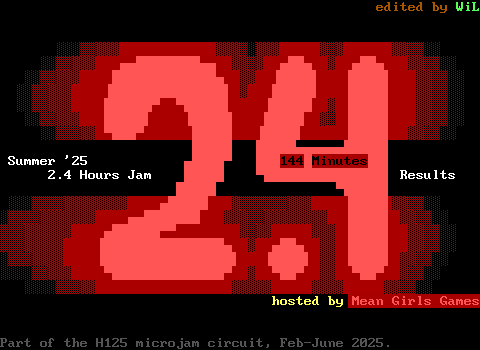Scenic View ➡
With its unusual non-violent gameplay, Hercules is free of needing to consider how players fight their way through boards, and focus instead on how they can be enjoyed when players are merely passing through. Players will find plenty of scenic views to admire, making the game one of the prettier releases of 1997. (Although not without competition, Rhygar 2, Gemhunt, and the original release of Defender of Castle Sin as well as later IF releases giving it a good run for its money). The game looks exactly how I expect 90s IF releases to: a heavy focus on natural environments, particularly forests, with enough variety to mix things up.
One of the more clever tricks seen in Savage Isle to enhance its natural beauty is through the use of passages to connect boards in some situations rather than using board edges. These games with open areas to explore usually focus on a making a cohesive world map, which today with tools like ZEdit2's ability to depict multiple boards at once is referred to as "Atlasing well". The passage, however, offers a unique advantage. It frees up room on the board to be dedicated to a horizon, letting boards that would have to be filled top-to-bottom with grass and dirt for the player to traverse instead allow the sky to be depicted, providing the sense that Finn arrived on a beautiful sunny day.
Savage Isle is a helpful reminder that the edges that divide ZZT boards aren't a negative. They too can be a part of the process of creating spaces. A world map whose borders don't stand out makes for a pleasant atlas, but ZZT atlases exist outside of the games themselves. Hercules is focused on making sure that screen by screen, the player sees something they'll enjoy looking at. Being restricted to a specific perspective in order to ensure a good looking PNG players shouldn't look at until they've finished the game is an expense suffered by the game itself.
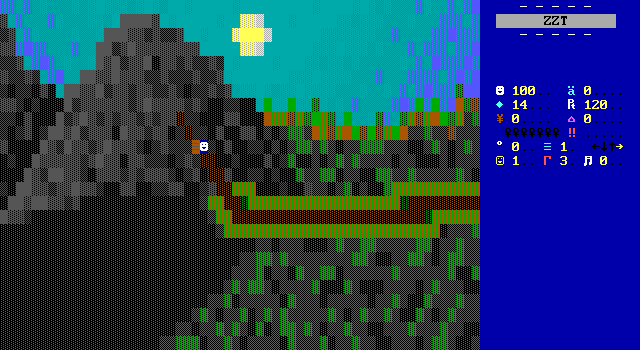
Hercules's passages allow the sky to peak over hilltops.
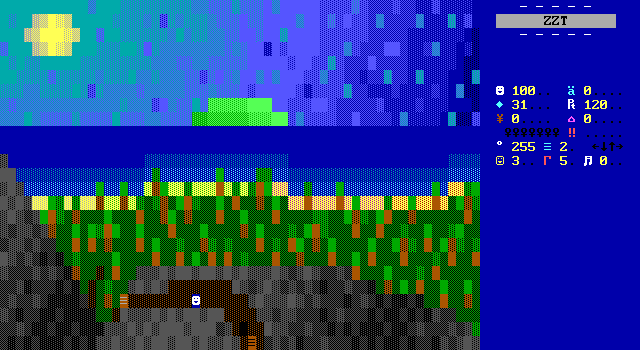
They also allow gorgeous views of a valley below as well as a neighboring island off in the distance.
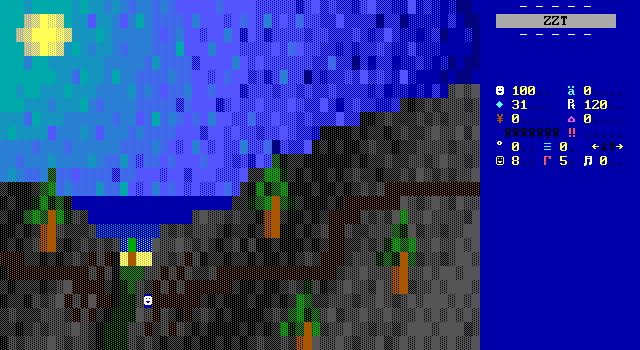
And even when not using passages for board connections, the focus on the sky can provide a sense of height when you reach a cliff.
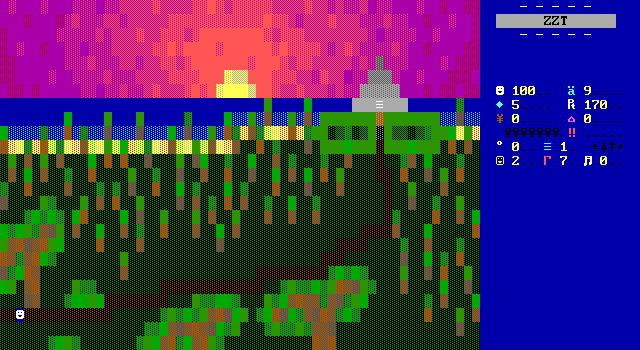
Most impressively, Hercules is able instill a real sense of scale as the sun begins to set and Finn seeks refuge for the night in the lizardmen's temple, the Hexaoatl. There have been countless great looking ZZT sunsets over the years, this one, which pulls the camera out to make the trees tiny dots sprinkled across the landscape creates a strong sense of that second wind one gets as your destination suddenly appears in sight after a lengthy trip.
None of this is to say that consistency isn't valued at all. Where you'll notice it most is in the game's interior spaces where only a portion of the board is needed to include everything necessary for the scene. Here, Hercules fills in the backgrounds with close-ups of the exterior surroundings. At first in Zinji village, this doesn't look that impressive, as Zinji's floors are just empties so the close-ups contain a lot of empty space.
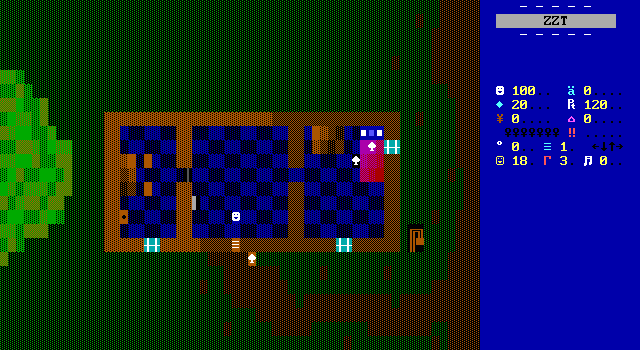
As Finn begins traveling through the hills, the environments are more natural, with grass and dirt roads which do a nicer job of using the extra space. In particular, I really like the signposts. On the zoomed out exteriors, Hercules opts for the de-facto standard signpost: . Once indoors, these signs become a larger, more complex shape built from objects that matches the look of the smaller variants quite nicely.
Savage Flaws
While there's so many positive things to say about Savage Isle, it's got some moments of friction. It shouldn't be too surprising that there are bits of the game in obvious need of improvement, given that this is one the earlier titles Hercules is credited on.
Huge amounts of the game are spent reading text. English isn't Herc's first language, so some dialog and phrasing can be a bit awkward. To me, that's always been part of the charm of Interactive Fantasies games, where young me was unaware of the company's Dutch origins and was always curious about the unusual way of speaking characters had. I don't consider this alone to be enough of a negative to impact anyone's enjoyment. However, it is worth being aware that the game's writing isn't going to be anything more than good enough for a game which involves a lot of reading.
Most dialog consists of very generic fantasy material. Asking who a person is, what job they have, what they can say about the location they're currently in. The inclusion of all this does make for a more developed world than you'd usually see in a 90s ZZT game, yet I'd be lying if I said the game's text was going to do something you hadn't seen before. Savage Isle would be a lesser game without these conversations, but it wouldn't change the events of the game in the least. Expect window dressing and nothing more out of it.

There's some user experience issue with the dialog in how players are presented with subjects to inquire for more detail about at the end of each topic. Some of these topics lead to other topics, and often have enough overlap with root level subjects that you may find yourself double-checking prompts to make sure that you did in fact hear everything a person had to say. An NPC may offer discussion on the pirates that have recently arrived on the island in their list of subjects, while also talking about their captain causing trouble when asked about how their business is doing. Prompts are inconsistently available, with some branches bringing up the original list of subjects, sometimes with new additions only available from the first subject, making it difficult to tick all the boxes of dialog available.
In at least one instance, players have to return to a character they've spoken with before once they've talked to someone else in order to get new topics to discuss. I found myself running into a barrier with Finn refusing to go onward because he hadn't actually finished information gathering to make it clear that a specific region was the next place to explore. Given the simple nature of the game, it's easy for players to predict where they'll be heading next, especially with all the signposts on the island. These roadblocks are very artificial, a workaround to not have to handle conversations with characters where Finn doesn't yet know what he needs to ask.

Finn's habit of refusing to go anywhere or do anything unless he has a reason for it can lead to a few potential instances of being stopped by invisible barriers that have Finn explaining that he has no reason to keep traveling in that direction. That's not so bad when you're in a small town and have no reason yet to speak with a sage, but it's more annoying when you follow the path to the mountains across a board and a half, climb to the top, and are stopped from entering the passage. A barrier like this would be much more beneficial to place as close to the initial crossroads as possible. While there are many gorgeous locations to behold across the island, they're a lot less gorgeous the second and third times.
The game's non-linear nature can also come back to bite you. The shaman in Zinji that sets Finn on his quest of recruitment establishes the specifics. The four humanoids are to gather tomorrow at midnight (don't get me started on the ambiguity there). Players guide Finn around, recruit the four humans, and then need go to bed to advance the game to the next day. None of the game's villages include an inn, or anywhere else to stay. Instead, Finn needs to head to the Hexaoatl, the temple of the lizardmen, another race that like the giants doesn't happen to have one of the most powerful humanoids.
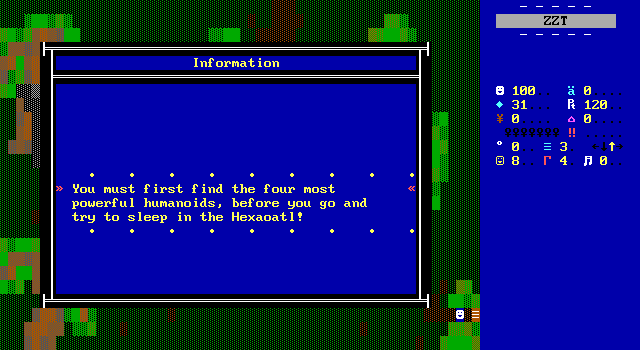
The path to the Hexaoatl begins on the same board as the entrance to the Halls of Mystery. This is in the deepest part of the woods, and effectively on the opposite side of the island compared to the starting bay where Finn lands his boat. I took a more roundabout route through the game, going into the valley before heading across the cliff. This meant finishing the Halls of Mystery, heading to Yumilos with the orb, heading all the way back to the cliff to reach Silgameth, and then having to retrace my steps to get back to Hexaoatl entrance.
Oh, and then the game points out that you also need to have some rations too, which meant another trip all the way to Zinji village to buy some, and only then being able to advance the clock and finish the game. (A second set of rations is needed for the excursion into the jungle to fight the djinn, but from the jungle entrance Zinji is just one board over.)
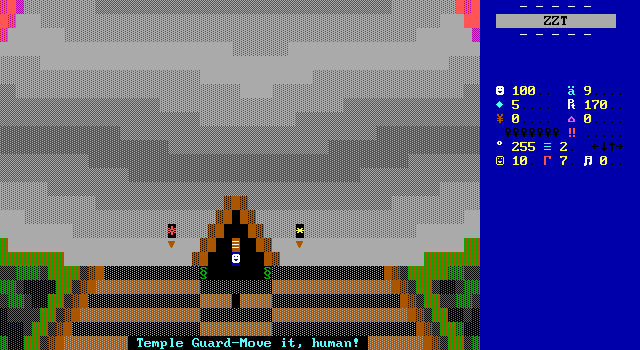
The first rations could have been cut out entirely. Let the lizardfolk provide a meal, it'll be fine. They're meant to be distrusting of a human trying to enter a sacred place, but they aren't entirely devoid of hospitality.
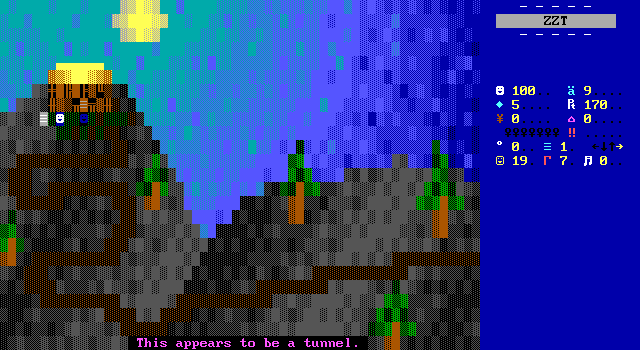
The game already provides a sensible fix for players that recruit Silgameth last. His home has a secret tunnel that he uses to avoid having to cross the cliff when visiting the giants. Another tunnel to the wood elves' village would be an easy way to limit the amount of backtracking if the temple is going to be so far out of the way.
Alternatively, just reposition the Hexaoatl to be somewhere earlier. Putting it closer to the village of dwarves would be enough to keep it in the middle of the island, making for a more reasonable journey no matter who happened to be the player's last recruit.
Finn Vs. Djinn
The finale was Herc's last opportunity to change course for the game. The jungle is established as an incredibly dangerous place where the djinn is far from the only way for an adventure's life to come to an end. Many authors wouldn't have stuck to the bullet-free adventuring, taking a last second pivot to include the action scenes the game has boldly lacked.
Hercules sticks to his guns. There will be no guns.

That doesn't mean he won't try to create some scary situations. What follows instead is a series of cut-scenes with players only able to look on and see the fate of the treasure hunters.
Under the light of a waning moon, a bridge running over "the infamous river of blood" brings the party to a halt. As powerful as the group may be, nobody wants to be the one to cross and see what happens. It creates a good sense of tension of what to do that is only broken by Yumilos speaking up that the shaman's magic scroll is to protect them from any evil magic found in the jungle.
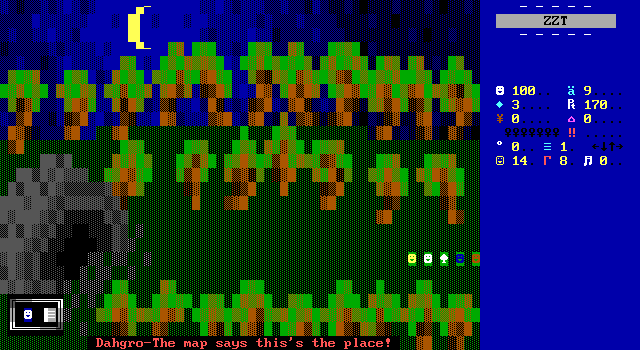
It's a tad anticlimactic. The bridge is crossed safely, and soon after the party finds the cave said to contain the treasure of the island and its malevolent guardian. Not pictured: A party of brigands mentioned only in passing that the group effortlessly beat up. Not as in I'm not including a screenshot, but as in "mentioned in the text as a thing that happened off screen".
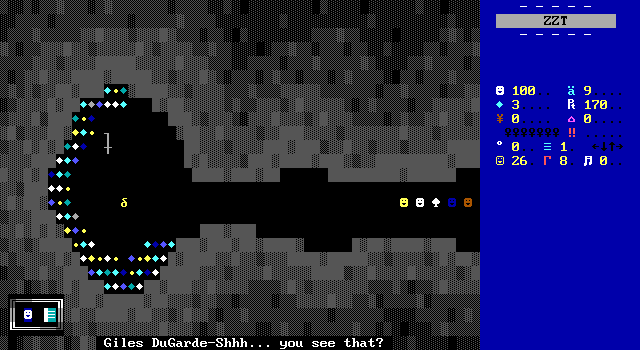
They enter the cave, knowing this is their moment. They consult the magic scroll for instructions before approaching and learn to defeat the djinn the most powerful humanoids all need to strike it once with their weapons. Finn awkwardly asks if this means his job is to simply sit and watch the fight, a question that is answered affirmatively.
The four approach, the djinn appears and threatens them, and then one after another they all attack. Each character carriers a unique weapon and that weapon is depicted on screen as you might expect from an RPG engine of the era, with swinging swords and axes, firing an arrow, and striking the djinn with a bolt of magic made from invisible walls. These animations add a level of detail that a lesser game would have skipped, opting to just #shoot a bullet or have the smiley faces change to to indicate an action being performed.

The djinn is destroyed with nothing to say beyond "ARRRGH!" and the scene ends. The next passage bringing players to the final screen of the game with its epilogue going into details of how the treasure was split amongst the party, as well as the villages of the island so that everyone could benefit. Finn sets sail for home, saying goodbye to the many people he met, and already planning to return again someday to visit the friends he made there.
Final Thoughts
Savage Isle looks and sounds like one of many fantasy adventure games for ZZT. It's only on actually playing it that the differences can really be appreciated. A fantasy game that revolves around the conversations you have more than the nameless enemies you smite sets it apart from the rest, including Hercules's later work with ZZT in games like the goofy Quest for the Immortals or dead serious Deceiving Guidance. It suggests that maybe games don't have to be about taking no prisoners, and that cooperation may be the key to success against powerful foes.

What you get is a pleasant walk through a fantasy world where everyone's problems aren't placed on your shoulders. Exploring Savage Isle is relaxing even, thanks to Hercules's dedication to creating boards with a view. While there isn't any danger to be had, there's still excitement in the form of discovering a new village, or running into somebody along the road that you can learn from. It's an approach that feels very much ahead of its time, taking players to a fantasy world and just letting them go through it at their own pace. The scenery and people are interesting enough to keep players focused, while the treasure hunting story gives players something to compel them to keep pushing forward.
When compared to Interactive Fantasies' other fantasy games like the constantly cited King's Quest ZZT and Quest For Glory, there's a very clear line between them. Going in, it's easy to see how Savage Isle could very well have been another game in a similar mold as the company's classics, but the difference in what is asked of players makes for a much more different player experience. Especially today. From an older player's point of view, KQZZT and QFG have what were then appealing RPG engines that now feel like they contribute very little. This identical engine shared between them used to be a selling point for the games, only to now be the most miserable part of the experience.
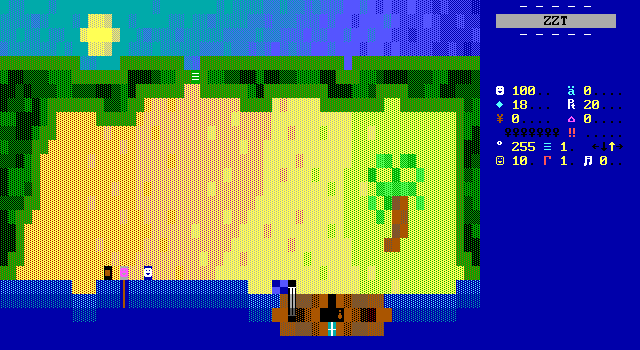
Savage Isle gives players a more laid-back adventure than those other games without the need for clunky forms of combat. Back then, the omission would be seen as a detriment, but now it's honestly a big part of the game's appeal to me. I got to essentially discover a new game similarly styled to some of the favorites of my childhood, that lacks the annoyances of going back to those titles again. This is a game that I would love to stream for a chill Friday evening, and one that anybody who enjoys getting lost in a ZZT world's atmosphere should check out. It's just a shame about the ZZT/MZX trivia section that breaks the flow of things and makes the game an annoyance that would keep me from readily suggesting newcomers to ZZT check it out.
That issue aside though, this game was exactly what I needed to play after a string of ambitious and well-meaning games that all turned into slogs. Even with the extra backtracking I foisted upon myself by not reaching Silgameth earlier, the views and quick sprints across each board without worry of stray enemies made it go by quickly enough to not really be a bother. Savage Isle has its bumps here and there, but why shouldn't it? It's one of Hercules's first releases, and shows immense promise that some of his later titles would go on to fulfill. This one may not be the greatest ZZT game ever produced, but it's darn fun to take in and one that I'd call a belated entry into my list of favorites.

